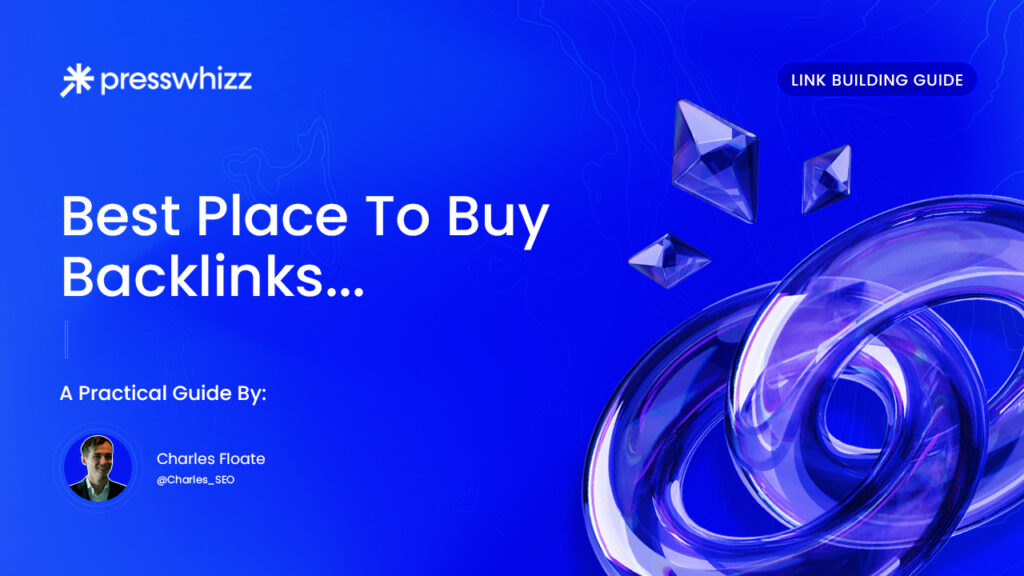Every SEO blog parrots the same tired advice: “focus on quality content, earn natural backlinks, don’t buy links, Google hates it.” Meanwhile, the agencies writing those posts are the same ones quietly buying backlinks at scale, slapping a margin on them, and selling them back to clueless clients as “white hat digital PR.”
The truth? Everyone at the top is buying backlinks. The difference between the winners and the losers is that the winners know where to buy, what to buy, and how to cover their tracks.
Whilst the losers end up with Fiverr spam, PBN trash, or agency markup links that should’ve cost $80 but somehow billed at $500+ and burn clients, which creates an anti-link building newscycle in our SEO industry.
This guide isn’t here to make Google happy. It’s here to make you rank. I’ll show you:
-
How to evaluate backlink sellers like a pro (and avoid the scams).
-
The marketplaces, vendors, and direct outreach spots that actually deliver.
-
When to go budget, when to go premium, and when to go full grey/black hat.
-
How to blend purchased links into a natural looking profile so you don’t tank your site.
This is my personal playbook for finding the best place to buy backlinks in 2025.
Why Buying Backlinks Still Works
Here’s the inconvenient fact most SEOs won’t admit: Backlinks remain the #1 ranking factor.
Google can push all the updates it wants, but at the end of the day, if your competitors have stronger, cleaner link profiles, and more authority as a result, you lose.
Yes, Google hates link buying. Yes, it’s technically against their guidelines. But you know what else is? Guest posts, sponsored content, link swaps, HARO abuse, press release syndication… Yet the biggest brands on earth are doing them daily.
Why buying backlinks works:
-
Algorithmic reality: PageRank and link equity are still baked into Google’s core. You’re not escaping it.
-
Time compression: Earning links organically takes months. Buying them compresses timelines into days and weeks.
-
Competitive necessity: If you’re in iGaming, finance, SaaS, law, health, CBD or just about any other competitive niche on the planet, then you know your competitors are already buying.
The catch? Not all backlinks are created equal. Buying the wrong ones can burn your site, which means manual actions, deindexing, wasted budget etc… Buying the right ones is how a DR40 site can outrank a DR90 programmatic dinosaur!
How to Evaluate a Backlink Seller
Before we even talk marketplaces or agencies, let’s make one thing clear: Most backlink sellers are selling the same lists of overpriced garbage that at the most end up being neutralized, but can often turn toxic.
They’re either recycling the same tired lists, pumping PBN garbage, or reselling links they got for pennies. If you don’t know how to filter the noise, you’ll get fleeced.
Here’s how I evaluate sellers:
Red Flags (Run the other way)
-
Guaranteed DR/DA without traffic – DA and DR are vanity metrics. With that being said, if a DR80 site has 200 visits a month in Ahrefs, it’s a corpse. Google doesn’t reward zombies.
-
Bulk packages – “50 backlinks for $99.” Translation: spam, auto-generated content, link farms. At best, you waste your money. At worst, you trigger a penalty.
-
Hidden inventory – If a seller won’t show you the sites before you buy, they’re hiding something. Transparent sellers are proud of their inventory.
-
Zero relevance – A casino site linking to your plumbing service? Trash. Google’s NLP understands context better than ever—irrelevant links are a footprint.
-
Fiverr/SEOClerks/Upwork “gurus” – 99% of these sellers are flipping PBNs. There are diamonds in the rough, but finding them takes time you could spend on real links.
Green Flags (What you want to see)
-
Real traffic – Use Ahrefs or SEMrush. If the site’s pulling 5k+ organic visitors per month, it’s a real property. 20k+ is even better.
-
Topical relevance – Links should live on sites in or adjacent to your niche. Google rewards context.
-
Transparency – A good vendor will show you live samples, site lists, metrics, and prices upfront. No cloak and dagger nonsense.
-
Content quality – Check past placements. Are they coherent, well-written articles on genuine sites? Or spun garbage on filler blogs?
-
Diversity – Sellers with networks across blogs, news sites, and niche outlets will help you build a link profile that looks natural instead of suspiciously uniform.
Think of it like dating: you want transparency, consistency, and signals that they’re not going to screw you behind your back.
The Top 5 Types of Places to Buy Backlinks
Now that you know how to sniff out scammers, let’s break down the actual places people are buying links today.
Each has pros, cons, and risk profiles, but I’d always recommend the most transparent services first, so you can do the most due diligence upfront.
1. Link Marketplaces
Think of these as the Amazon of backlink buying. Platforms like PressWhizz, Bazoom, Collaborator.pro, and Authority Builders give you curated inventories of sites where you can buy placements with a few clicks.
-
Pros: Transparent, wide selection, usually real sites with traffic. Easy for beginners.
-
Cons: Markups are high, footprints if you stick to one platform too much, everyone is buying from the same pool.
2. Agencies & Resellers
SEO agencies love to act holier-than-thou about “white hat link building,” but most of them are just buying from the same marketplaces above and adding 3–5x markup.
-
Pros: Hands off, they do the strategy for you.
-
Cons: You’re paying inflated prices for the same links you could’ve bought yourself.
3. Direct Outreach / Private Deals
This is where the pros play. Instead of going through a marketplace, you negotiate directly with publishers, editors, or site owners.
-
Pros: Cheaper (no middleman), exclusive placements, stronger relationships for long-term deals.
-
Cons: Time-intensive, requires negotiation skills, higher upfront rejection rate.
4. Black Hat Boards & Forums
Places like Black Hat World and private Telegram groups are still buzzing with backlink sellers. Yes, you can find monster deals here. But you can also burn your site in a week if you don’t know what you’re buying.
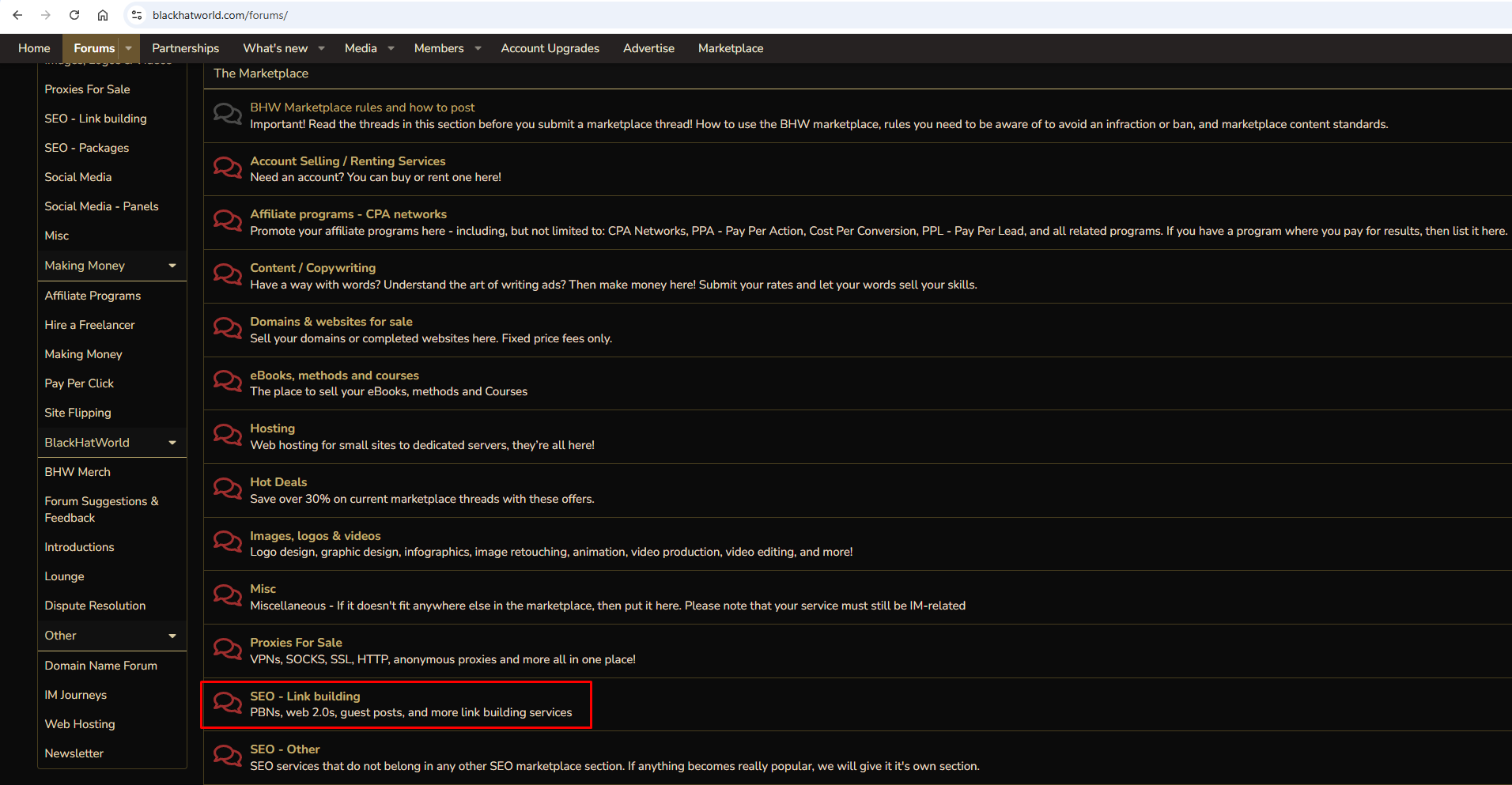
I prefer to network rather than buy from these communities.
-
Pros: Cheapest links, huge variety, insider tricks.
-
Cons: High risk. Lots of PBNs, spam tactics, and zero accountability. Buy here if you’re churn and burn or know exactly how to launder a link profile.
5. Freelance Marketplaces (Fiverr, Upwork)
These are the last resort. You might find a gem, but 90% is garbage. If you’re even considering Fiverr backlinks, you’d better know how to analyze sites or you’re flushing money.
The Best Place To Buy Backlinks in 2025
It’s really hard to recommend competitors, I used to be a big fan of Ereferer (Which was a French platform with a large English database for very cheap) but it got acquired and prices were jacked up last year, which is a very common case in SEO.
A lot of the reason I personally chose to become a partner with PressWhizz was because of the lack of transparency, price gauging and inefficiencies a lot of the largest marketplaces, and especially service/product providers, in links have.
So as a shameless plug, I am going to put us at #1, BUT I am going to give you the other vendors I still utilized under my toolkit, and give you a few alternatives I think do some good things in our industry as well.
#1 – PressWhizz
Aside from our services being the quickest, with links on average being delivered in just 18 hours, vs the industry standards ~21 days) and most affordable, we also try to have and consistently expand the best FREE tool suite in link building.
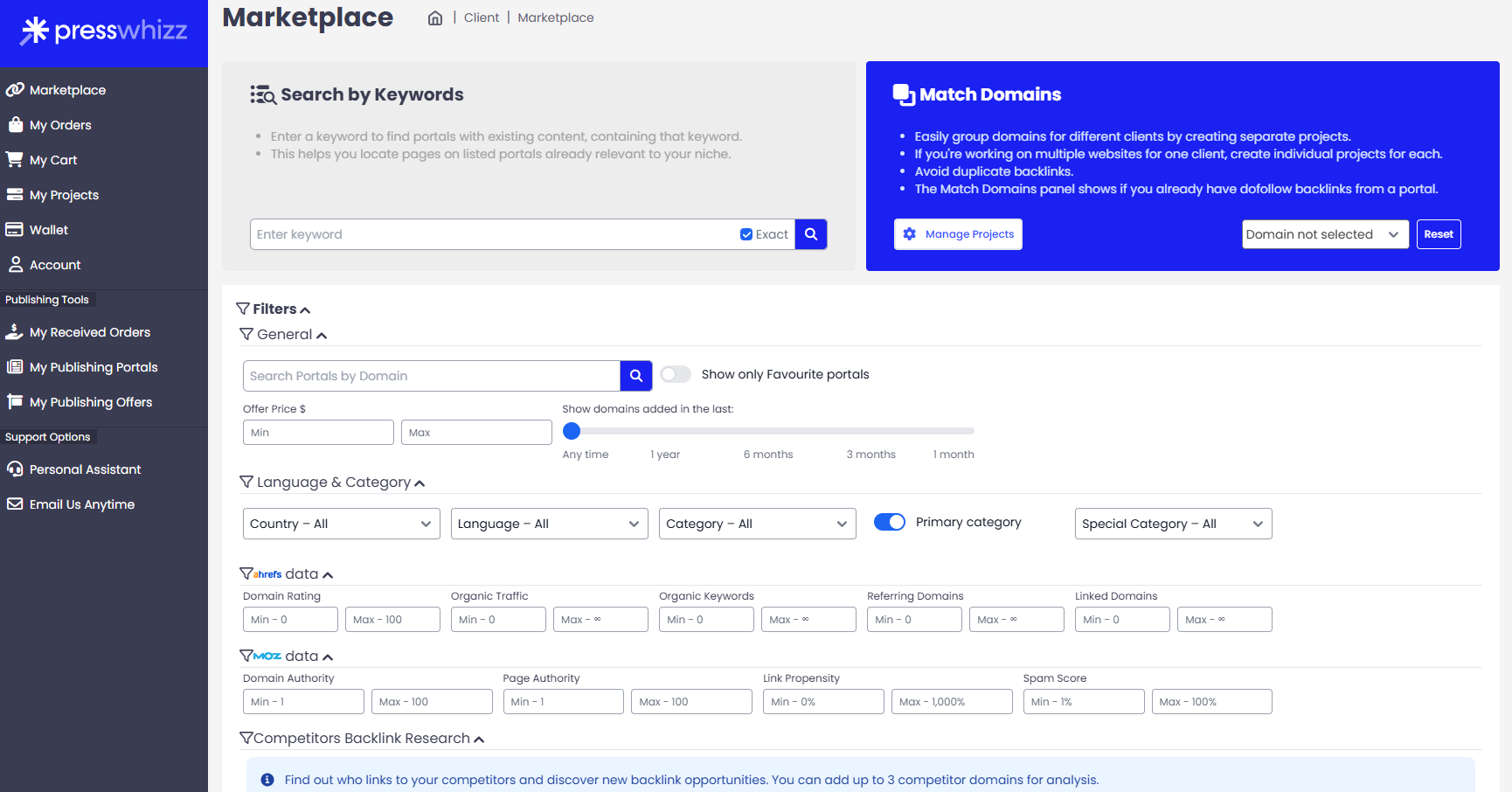
Once you’ve signed up for the marketplace, you’ll be able to:
- Blacklist Existing Referring Domains From Your Site
- Find Links Powering Your Competitors (Up To 3 At A Time – But Unlimited Uses)
- Use Our Internal Search Engine (We Scrape Our Inventory) To Find Pages With Your Keywords On
- Filter Publishers by Category, Country, Language, DR, DA, Traffic, Keywords, Referring Domains, Spam Score & More!
- And We Have A Range of FREE AI Tools Coming Out in Q4 2025!
Our customers also get access to free webinars, training videos and private resources I craft to help you get the most out of your link building campaigns.
#2 – SEO Builder
Whilst AI and automated citations have seen a massive rise over the last 12 months, from our testing, manually created and controlled citations are still levels ahead in terms of average impact.
SEO Builder has the best manually audited and built social profile and citation packages in the industry from my testing, and the owner, Robert, has always been a stand up member of the community!
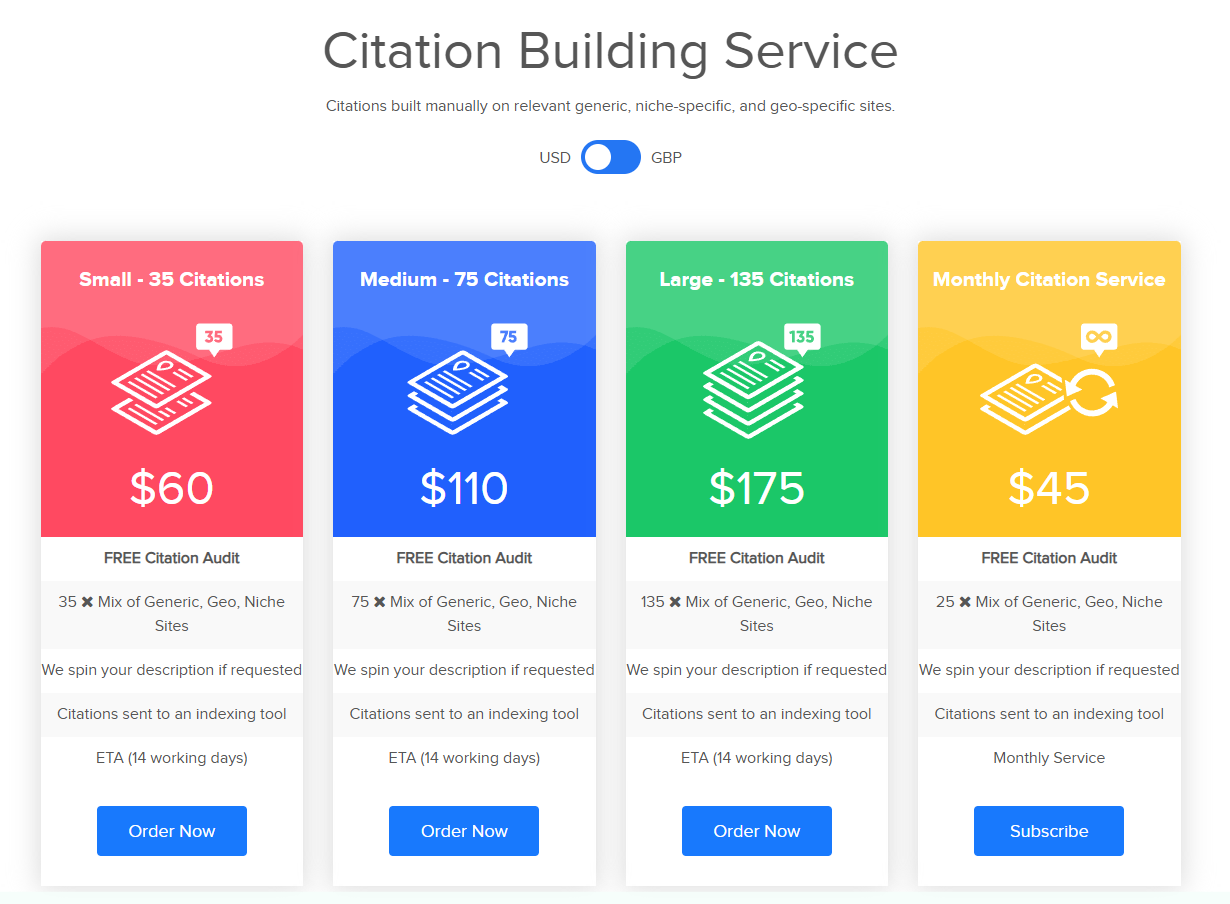
I haven’t used their other services, so can’t attest to them.
#3 – Authority Builders
Authority Builders was Matt Diggity’s marketplace before he sold it to a VC fund.
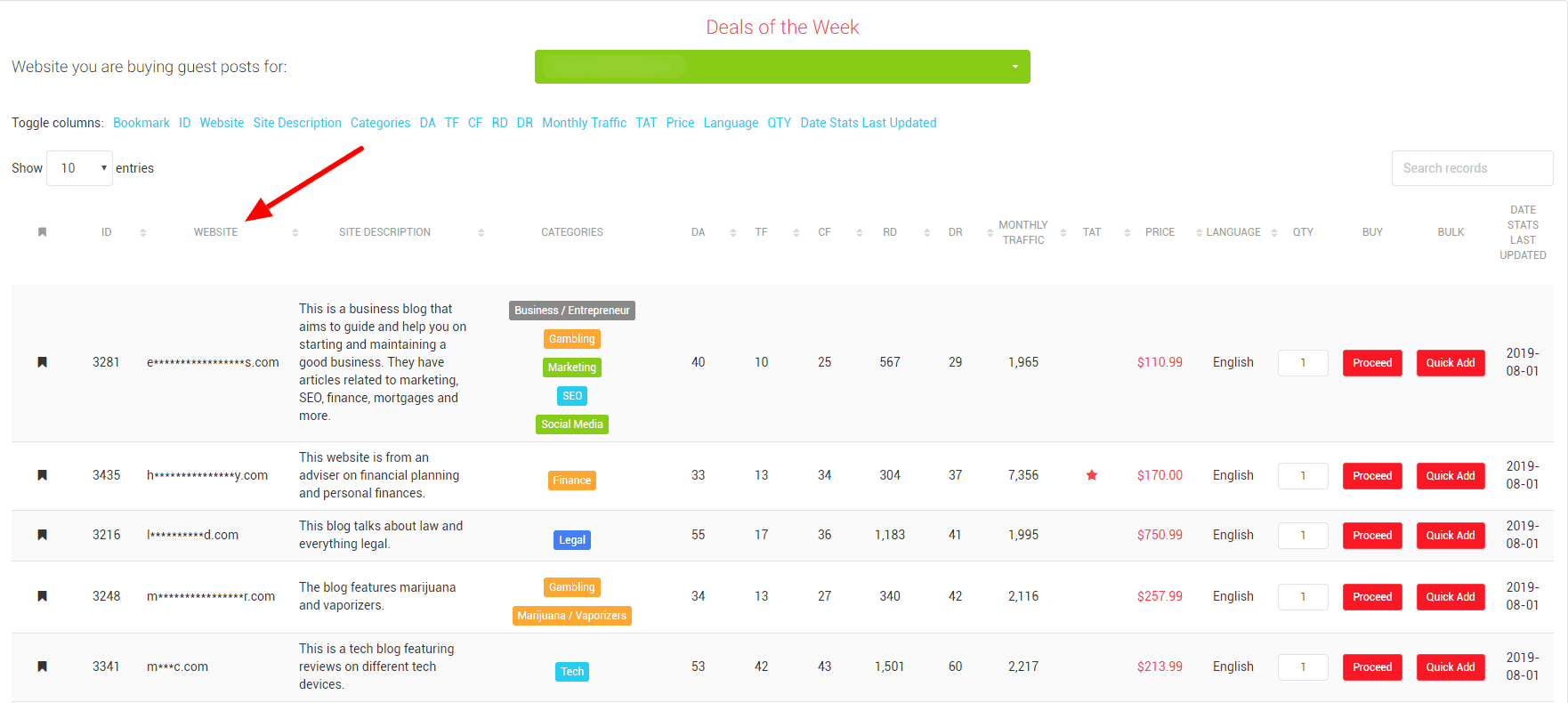
It’s been around for many years, and was previously under a different name, which means two things:
-
Pro: They’ve got one of the most stable inventories and consistent delivery systems in the game. You’ll get links on legit blogs with traffic, and they’ve invested heavily into cleaning up spammy inventory.
-
Con: You’re paying a “brand tax.” Because of Diggity’s personal brand, you’ll usually be shelling out more than the same link would cost via a smaller vendor. Also, the selection leans heavily into generalist blogs instead of niche killers.
#4 – WhitePress
WhitePress is the “corporate” version of a link marketplace. They started in Poland, then expanded across Europe, and now have a monster sized team for this industry, and a huge database with publishers in dozens of countries.
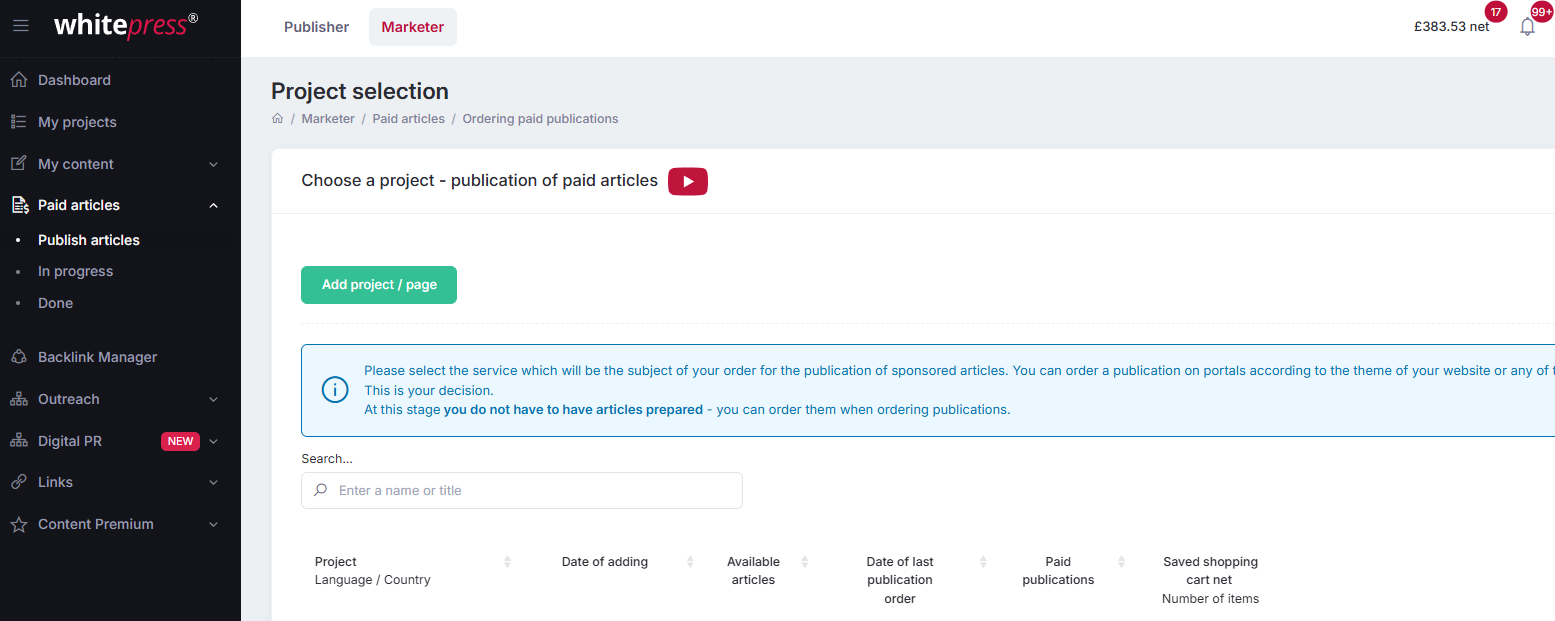
They attend and sponsor almost every event in SEO too!
-
Pro: If you want scale in international markets, WhitePress is king. You can buy placements in obscure geos your competitors haven’t even thought of.
-
Con: Pricing is very high. Quality varies like crazy. Their system is built for volume, so you’ll see a lot of zombie DR70 sites with 200 visits a month. Filtering is essential, or you’ll torch budget fast.
#5 – Collabrator.Pro
This is Ukrainian marketplace that’s been scaling hard! They have solid pricing, a fairly large inventory but a pretty hard to use/complex interface which doesn’t make it as easy as others to find the right links for your site.
-
Pro: Inventory is surprisingly good for the cost, especially for regional and local news sites. Lower markup compared to Authority Builders or FatJoe.
-
Con: UI feels clunky, customer service is mid, and some sites are clearly resellers disguised as publishers.
#6 – FatJoe
FatJoe was the first to really productize backlinks, and as a result, they offer every type of link link building service (and now even AI visibility services) that you can imagine, though they’re usually marked up at a fairly high price.
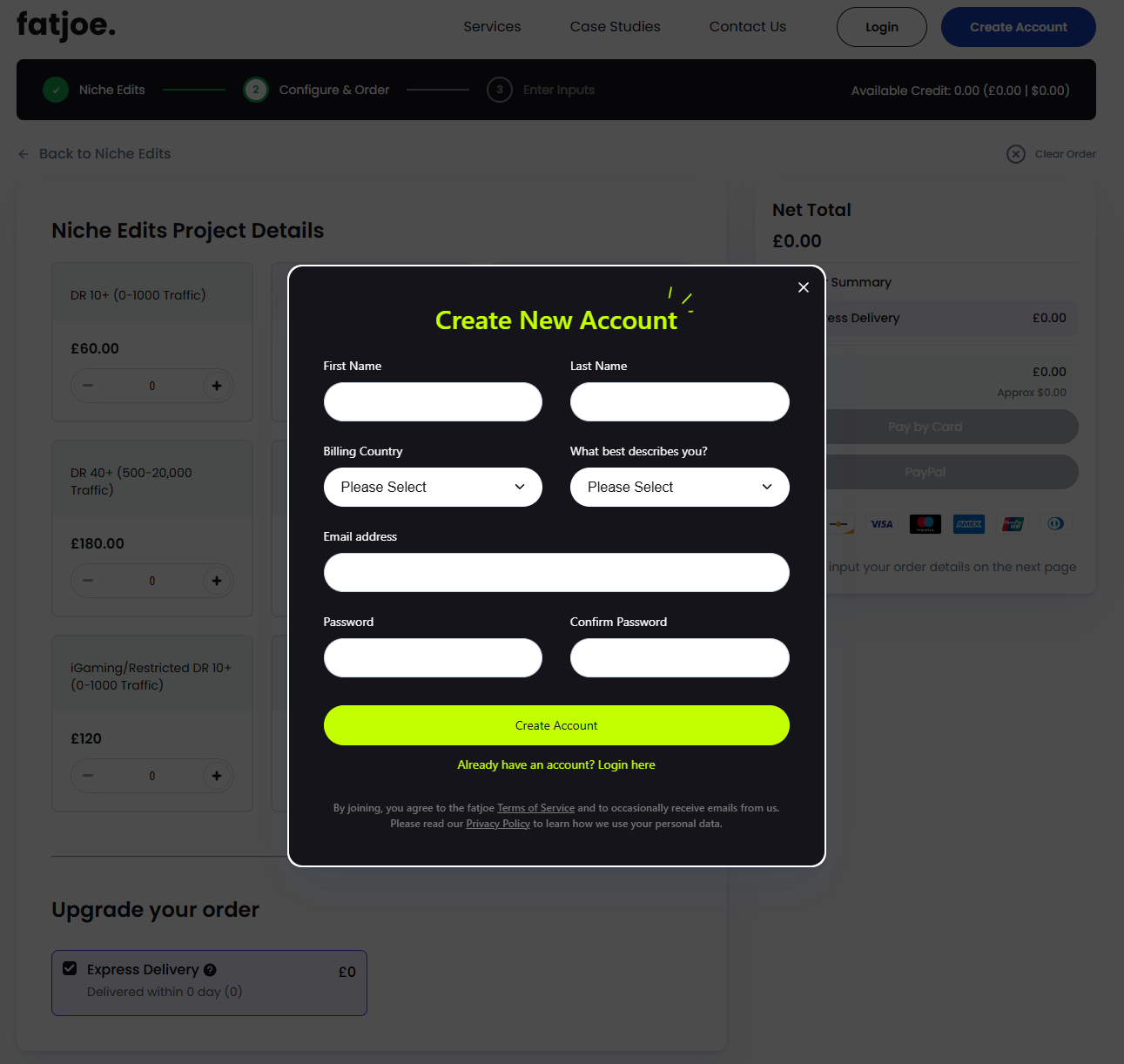
You also can’t pick the sites you want the links on, and the lowest price they have for niche edits and guest posts is 2x the price of the lowest on PressWhizz.
-
Pro: If you just need content + links delivered without micromanagement, they’re efficient. Great for agencies that want bulk orders without hiring an in-house outreach team.
-
Con: Links are rarely niche-relevant. The quality is fine for padding out a profile but won’t move big-money SERPs. You’re basically paying for average guest posts at scale.
Verdict: Good for pillow links or agency reselling. Don’t expect to rank for YMYL keywords on FatJoe fuel alone.
#7 – Searcharoo
Searcharoo is more of a boutique vendor, UK based, smaller team, but they’ve been quietly building a decent rep. Led by James Dooley, Karl Hudson and Kasra Dash, it’s also got some of the industries biggest names behind it.
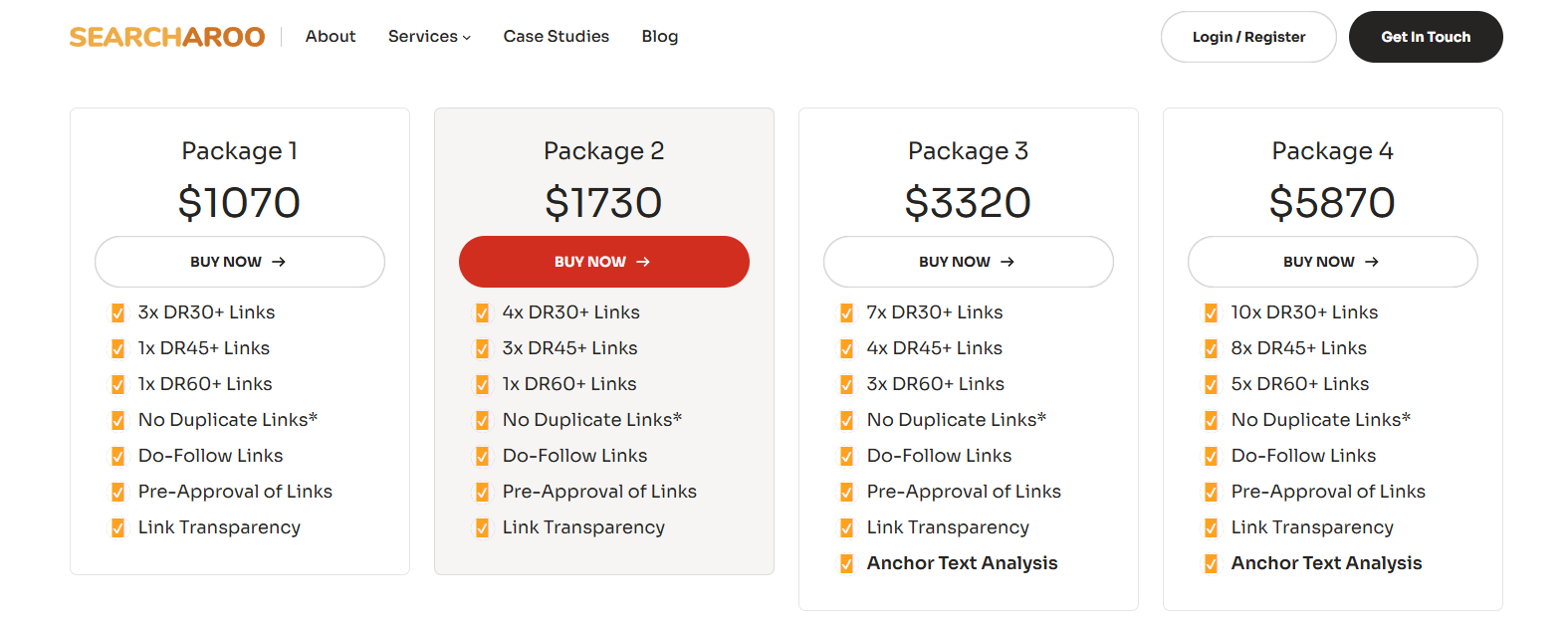
With that being said, I’d only recommend a handful of their services as they’re more of a McDonalds for links with every service under the sun, but at bottom rate pricing, mean the quality is often lower too.
-
Pro: Transparent pricing, solid communication, and less of the bloated inventory churn you get with Authority Builders. Their niche edit packages are particularly solid for mid-tier budgets.
-
Con: They don’t have the inventory size of a PressWhizz, WhitePress, or Authority Builders. You’ll hit the ceiling fast if you’re scaling hundreds of links a month.
Verdict: Strong option for SMBs or affiliates who want handholding and quality over quantity.
#8 – MagicPR
Press release syndication done properly, and another provider I’ve been using for the the last 10 years now!
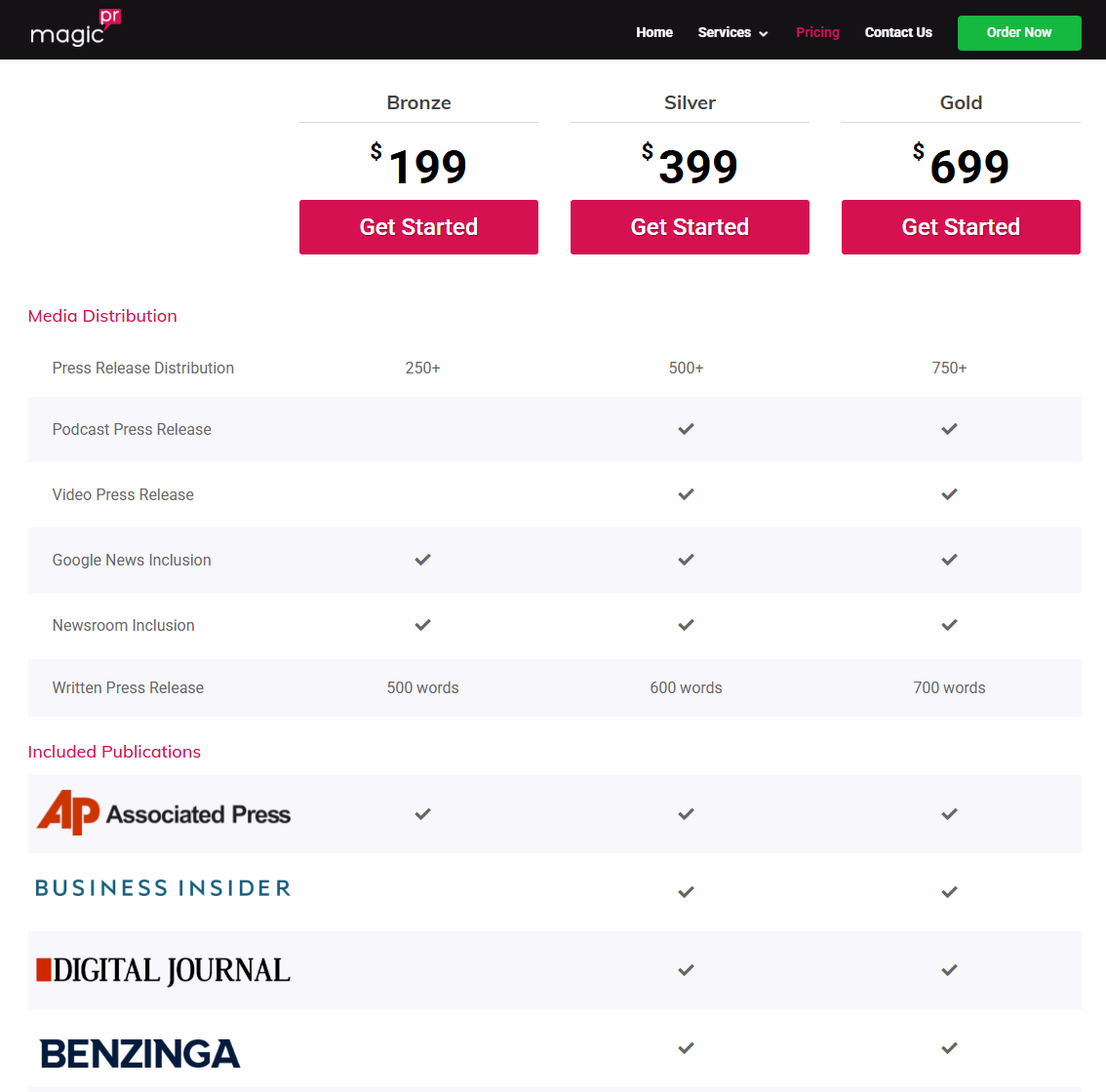
They have some very affordable packages for the sites you get, and I mostly use them for entity stacking or as signal scaffolding, not your primary power source which a lot of SEOs like to try and use press releases for.
Pro:
-
Fast brand/entity recognition across “trusted sources” (Yahoo, MarketWatch, GlobeNewswire, etc…)
-
Predictable delivery and reporting. Easy to hand to juniors.
Con:
-
Most placements are nofollow/sponsored and pass limited juice. Treat as trust & crawl enhancers, not rank movers.
-
If you point PRs straight at money pages with commercial anchors, you’ll paint a target on your back.
How I use press releases:
-
Launch/refresh cycles, news/launch jacking, new product/feature drops, rebrands, geo-expansion or new site entity stacking.
-
Link to brand/homepage (or a neutral hub page), then internally route equity.
-
Follow with 2-6 weeks of contextual links (marketplace + direct deals) and MagicPR includes T2 to the PR URLs.
#9 – Legiit Marketplace
A freelancer marketplace with pockets of quality buried under a sea of mediocre or even the occasional cowboy… You can pull gold if you vet like a psycho though!
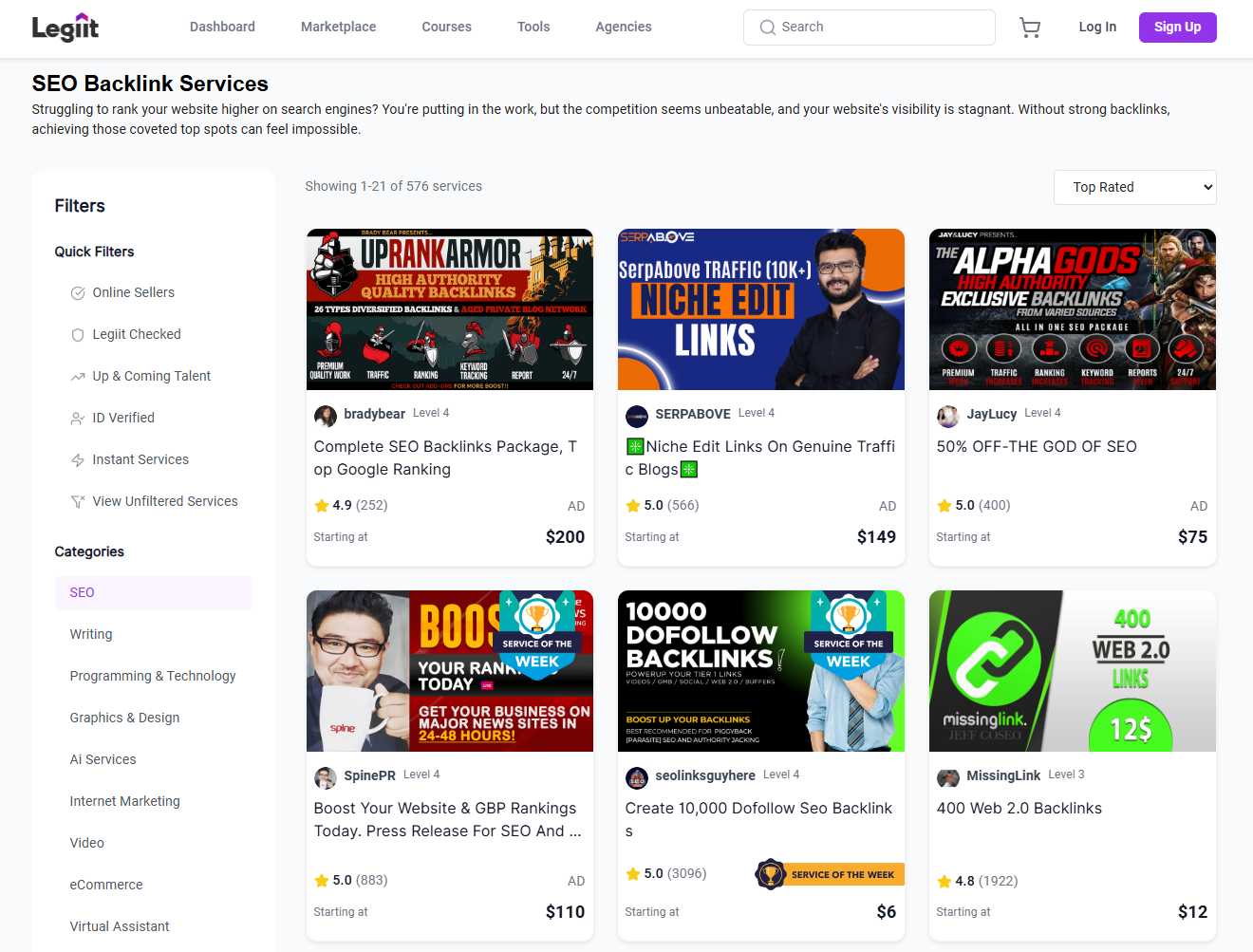
And once you hit gold, I tend to re-use and abuse until it doesn’t work anymore or they stop providing the same level of quality.
Pro:
-
Undermarket pricing on citations, niche edits, and digital PR if you find vetted sellers.
-
Good for building pillow layers (citations, socials, brand mentions) and low-to-mid tier edits at scale.
-
Direct seller chats = negotiable bundles.
Con:
-
Inconsistent QA. Lots of resold inventory and PBN wolves in “real site” clothing.
-
Metrics gaming is rampant. DR promises without traffic = bin.
#10 – MyProfitEngine
Private vendor/service shop ran by a very lovely family business who attend a lot of events as father and son, which is rare in this indstry. Not mass market like WhitePress; think smaller footprint with curated offers.
(Charles’ experience note: I don’t have public benchmark data on their entire inventory, assess per the framework below.)
Pro:
-
Less saturation than the big marketplaces = reduced footprint.
-
Can source custom placements instead of just recycling shared inventory, and has been increasing outreach capacity.
-
Stronger handholding and communication compared to faceless platforms.
Con:
-
Inventory overlap still exists, some sites are pulled from the same wholesalers.
-
Smaller scale means limited volume if you’re running campaigns needing 100s of links per month.
-
Pricing can feel inflated if you don’t vet per site traffic and outbound patterns.
How Much Do Backlinks Cost?
Here’s the ugly truth: Backlink pricing is a complete wild west. Two sellers could pitch you the same site, one quoting $50 and the other $500.
Agencies love to inflate margins, marketplaces add their cut, and desperate sellers dump low quality links at bottom barrel prices that end up nuking your rankings…
So what does a realistic cost structure look like?
-
Low-Tier ($10–$50/link): Usually Fiverr, Black Hat World, or SEOClerks. Expect PBNs, spun guest posts, or low traffic blogs. Fine if you’re running churn-and-burn, but dangerous for brand sites.
-
Mid-Tier ($80–$300/link): Where most legit marketplace and outreach deals live. These are contextual placements on niche blogs, regional news sites, or mid-authority publishers. This is the sweet spot for most projects.
-
High-Tier ($500–$2,500/link): These are premium editorial placements, top-tier publications, or exclusive niches (think finance, health, SaaS). Big money, but they move the needle hard, especially for YMYL keywords.
Pro Tip: Don’t blow your budget on DR metrics alone. A DR90 site with fake traffic is worthless. Instead, prioritize sites with real, consistent organic traffic and topical relevance.
Buying Links Without Getting Penalized
Buying backlinks works, but only if you don’t leave a footprint. Too many SEOs tend to buy a bunch of random packages all at different (or even worse, the same) time, which leads to a random mix of signals that can often trigger Google’s anti-spam systems.
Here’s how you build protection into your link buying strategy:
-
Anchor Text Mix
-
50–60% branded, URL, or generic (“click here”) anchors.
-
30–40% partial match and semantic variations.
-
<10% exact match (save these for the most authoritative sites).
-
-
Diversify Sources
-
Make sure you have your entity stacking on lock first, having Google trust your brand goes a long way to protecting links.
-
Layer in pillow links (citations, social profiles, directories) to soften the footprint.
-
-
Tiered Linking
-
Boost expensive placements with cheap Tier 2 links (Web 2.0s, niche edits, PBN posts etc).
-
This maximizes juice without risking your core pages.
-
-
Monitor Everything
-
Use Ahrefs, SEMrush, or Linkody to track new links.
-
Set alerts for sudden deindexing or traffic drops on linking domains.
-
-
Blend with Organic Plays
-
Publish linkable assets (guides, tools, stats pages) so your purchased links don’t stand out like a sore thumb.
-
If you want to go one step further, use a tool like LinkResearchTools (Expensive sub) to check the toxicity score and have a threshold to make sure you are only sending positive signals to your site. We usually max out at ~1,300.

Taking these extra steps is often tedious, but is also often the difference between a clean looking link profile that wins and a glowing neon “penalize me” sign.
When to Go White Hat vs. Black Hat
Not every project deserves squeaky clean link building. Sometimes, speed and aggression matter more than longevity. Here’s how I decide:
-
Brand Sites / Long-Term Assets: Stick with clean marketplaces, outreach, and premium buys. Blend with legit content and PR.
-
Affiliate Sites (Mid-Risk): Mix clean buys with more aggressive edits, marketplace bundles, and pillow spam. Manage risk but prioritize ROI.
-
Churn & Burn / Seasonal Sites: Go wild. PBNs, SAPE links, forum blasts. Rank fast, cash out, and accept the crash.
The biggest mistake SEOs make is applying the wrong risk tolerance. Don’t build your mom’s local flower shop website the same way you’d build a Black Friday CPA churner.
Final Thoughts
If you’ve made it this far, you’ve probably realised that moralising link buying is theatre. Google’s guidelines are a negotiation tactic, not a law of physics. The market rewards whoever compounds authority fastest with the least detectable footprint. That’s it.
The people crying “just write better content” are either selling a content retainer or quietly buying the same inventory they tell you to avoid. Winners aren’t purer; they’re sharper.
Backlinks are an economic lever. Used correctly, they collapse time. You’re not “cheating,” you’re closing the gap between where your site is and where it deserves to be based on product, offer and intent.
The mistake most SEOs make isn’t buying links, it’s buying carelessly, without cohesion with the rest of the site/OnPage and with a terrible velocity. They fixate on vanity DR and accept placements that never rank, never get crawled, never pull a keyword, and then call the whole channel broken. It’s not broken; your due diligence is.
The other truth nobody wants to say out loud: Footprints are created by behaviour, not a single link. Agencies create them by ordering the exact same anchors across the same sellers on the same Tuesdays every quarter, and then wonder why an update slaps them.
Smart operators manipulate context, not just metrics. They build brand signals before aggression, they feed internal links so equity actually travels, and they spread risk across vendors, geos and page types so nothing looks like a campaign, because real brands don’t look like campaigns.
You don’t need 1,000 links; You need enough of the right links to bend the curve and keep it bent. When you stop chasing volume and start buying outcomes, budgets get smaller and profits get louder.
If a placement won’t move a page, power another page that will. If a site can’t push rankings, use it for entity reinforcement, crawl scheduling, or to insulate a spikier move. Everything has a place on the chessboard if you stop playing checkers.



